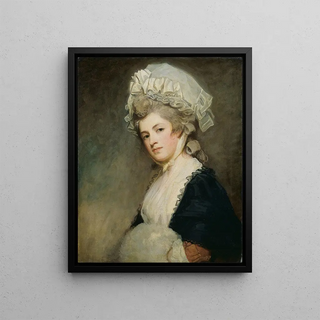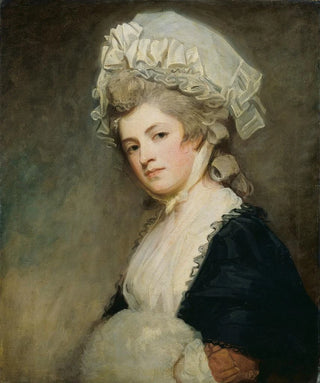Art print | Mme Mary Robinson - George Romney


View from behind

Frame (optional)
George Romney's "Mme Mary Robinson" art print embodies the elegance and sophistication of the 18th century, a time when portrait painting reached unparalleled heights. This depiction of the renowned English actress and poetess Mary Robinson goes beyond merely capturing her physical appearance; it also evokes her fascinating personality and social status. Through this canvas, Romney manages to transcend the simple portrait to offer a true immersion into the spirit of a woman who was both muse and iconic figure of her era. The soft light bathing Robinson's face, along with the refined details of her attire, testify to the artist's technical skill and keen sense of observation.
Style and uniqueness of the art print
George Romney's style is distinguished by his ability to blend realism and idealization. In "Mme Mary Robinson," he uses a delicate color palette to create an intimate atmosphere, while highlighting the natural beauty of his model. The drapery of the dress, carefully painted, adds a tactile dimension to the art print, inviting the viewer to appreciate not only the image but also the texture of the materials. Mary Robinson's penetrating gaze, imbued with mystery, seems to capture attention and provoke reflection on her tumultuous life. Every detail, from the sparkling jewelry to the elaborate hairstyle, is thoughtfully designed to reflect not only the fashion of the period but also the complex personality of the woman portrayed. This approach makes the art print a perfect example of portraiture where aesthetics and character meet harmoniously.
The artist and his influence
George Romney, born in 1734, is one of the most renowned portraitists of his time, and his influence on British art is undeniable. Trained in the shadow of the great masters, he developed a style that is uniquely his own, combining finesse and psychological depth. His work with emblematic figures of his society, such as Mary Robinson, allowed him to establish himself as an essential figure in portrait art. By incorporating narrative elements into his works, he paved the way for a new way of conceptualizing the portrait, where the subject is not only a

Matte finish

View from behind

Frame (optional)
George Romney's "Mme Mary Robinson" art print embodies the elegance and sophistication of the 18th century, a time when portrait painting reached unparalleled heights. This depiction of the renowned English actress and poetess Mary Robinson goes beyond merely capturing her physical appearance; it also evokes her fascinating personality and social status. Through this canvas, Romney manages to transcend the simple portrait to offer a true immersion into the spirit of a woman who was both muse and iconic figure of her era. The soft light bathing Robinson's face, along with the refined details of her attire, testify to the artist's technical skill and keen sense of observation.
Style and uniqueness of the art print
George Romney's style is distinguished by his ability to blend realism and idealization. In "Mme Mary Robinson," he uses a delicate color palette to create an intimate atmosphere, while highlighting the natural beauty of his model. The drapery of the dress, carefully painted, adds a tactile dimension to the art print, inviting the viewer to appreciate not only the image but also the texture of the materials. Mary Robinson's penetrating gaze, imbued with mystery, seems to capture attention and provoke reflection on her tumultuous life. Every detail, from the sparkling jewelry to the elaborate hairstyle, is thoughtfully designed to reflect not only the fashion of the period but also the complex personality of the woman portrayed. This approach makes the art print a perfect example of portraiture where aesthetics and character meet harmoniously.
The artist and his influence
George Romney, born in 1734, is one of the most renowned portraitists of his time, and his influence on British art is undeniable. Trained in the shadow of the great masters, he developed a style that is uniquely his own, combining finesse and psychological depth. His work with emblematic figures of his society, such as Mary Robinson, allowed him to establish himself as an essential figure in portrait art. By incorporating narrative elements into his works, he paved the way for a new way of conceptualizing the portrait, where the subject is not only a






